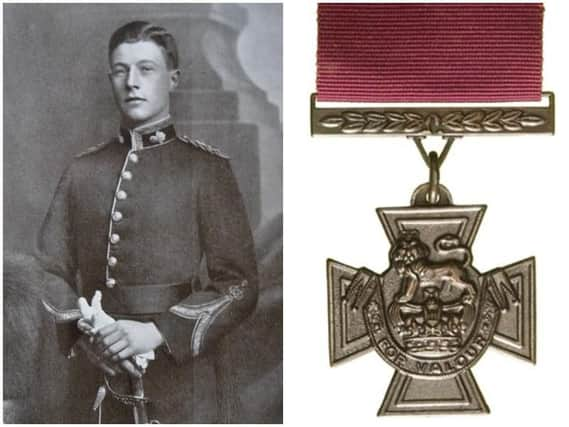Lancashire schoolboy who became the first great hero of the war


Maurice Dease went to Stonyhurst College, aged 13 years, in 1903 and, throughout his time spent there, he was noted for his determination, open nature and care for others, demonstrated in acts of kindness such as his guidance to Mass every morning of Fr Myers SJ, an elderly and infirm member of the Jesuit community. In recognition of his many qualities, he was appointed twice as head of his year, but it was his demeanour in other parts of the school which drew the attention of those who taught and cared for him. It was said of him that, if something needed to be done and done well, Maurice Dease was the one to do it. These qualities, which were developed and brought to fruition at Stonyhurst, would be demonstrated to the full in the most dramatic of circumstances on the bridge at Nimy during the Battle of Mons on August 23, 1914.Dug in along the tow path of the canal (now known as the Quai des Anglais), the 4th Royal Fusiliers waited for the advancing Germans who they knew would have to capture the bridges over the canal to make further headway. Boats had been burned during the night to prevent a makeshift crossing being made and the smoke from tar and beam still hung in the air and stung the fusiliers’ eyes. Little did they know that they were faced with vastly superior numbers and they were to become the anvil upon which the German hammer blow was to fall.As a German reconnaissance party appeared, the fusiliers chased them off with a burst of rapid fire and then the advancing German army began to make their way through the buildings opposite and down to the canal. Here, the railway bridge was the only crossing available to them and Lt Dease positioned his machine gun section of two Vickers Maxims, one on either side of the track, to hold the Germans at bay. The Germans were then met by a storm of rifle fire meted out by the gritty, professional fusiliers, who had spent years perfecting their craft on the range. As Capt. Osburn of the 4th Dragoon Guards later wrote: “I shall not easily forget the overture of that extraordinary battle: a crackling sound, exactly like that of an October bonfire into which a cartload of dry holly boughs had been suddenly thrown.”A German writer, Captain Walter Bloem of the 12th Brandenburg Grenadiers, described the experience of being on the receiving end of such murderous firepower, “The enemy must have been waiting for this moment to get us all together at close range, for, immediately the line rose, it was as if the hounds of Hell had been loosed at us, yelling, barking, hammering, as a mass of lead swept in amongst us.”As the battle continued, Lt Dease and his machine gun section would draw fire of all calibres from the advancing Germans in their effort to prise their grip of the bridge. With no artillery support, they were in a desperately exposed position. The correct posture for the man firing a Vickers is to sit upright, straight-backed and not hunkered over to squint along the sight, as one would imagine, so as a consequence, he was exceptionally vulnerable. As Lt Dease attended to his section, he was felled by a bullet below the knee. He refused the entreaties of his men to leave the position and, applying a field dressing, continued to ensure his guns were properly supplied with men and ammunition. As the German attack intensified, his guns were vital in keeping them at bay. As Lt Dease limped towards the machine gun, he was struck down by a bullet in the side.Dragged a short distance away, Lt Dease was concerned that the machine gun to the left of the tracks had been put out of action and he dragged himself towards the emplacement. As he did so, he was then winged in the neck. The situation was now becoming desperate all along the canal bank as the Germans rained in shrapnel and high explosive, and the machine gun position continued to be deluged with fire. When the remaining machine gun fell silent once more, Lt Dease took over control of the gun himself and blazed away in support of his battalion below. Wounded in the head, he refused to leave the gun and then a bullet struck him in the chest and he collapsed on to the sandbags.Lt Dease was carried from the position by his friend Lt Steele, leaving Pte Sidney Godley with the gun to keep the Germans at bay. As the retreat began, the Germans took the bridge and Godley, badly wounded in the head, threw the remaining machine gun into the canal and became a prisoner. Lt Dease’s body was recovered and, with the permission of the German officers who had watched him throughout the action, was laid to rest in the family vault of the Maigret family at St Symphorien. After the war Maurice was reinterred alongside his comrades in the nearby military cemetery.Lieutenant Maurice Dease, 4th Royal Fusiliers, was to be awarded the first Victoria Cross of the Great War. The second Victoria Cross was awarded to Private Sidney Godley for continuing to keep the machine gun in action once Maurice had been killed.* A full account of Lt Dease’s bravey is included in a new book, On Courage, which features 28 stories of valour displayed by recipients of the Victoria Cross and George Cross. It is published by Constable priced £20.Paul Garlington is a teacher of History at St Mary’s Hall and Stonyhurst College, near Clitheroe. He is also a recognised and published Battlefield Historian and Battlefield Guide. He has led connoisseur, corporate and school tours to the various battlefields on The Western Front for over 20 years. More on Paul Garlington can be found at: www.paulgarlington.com. He can be contacted on [email protected]; or 07824 447005.